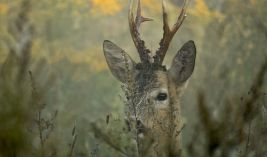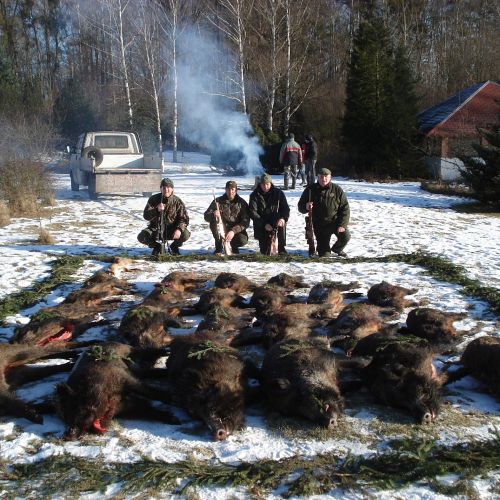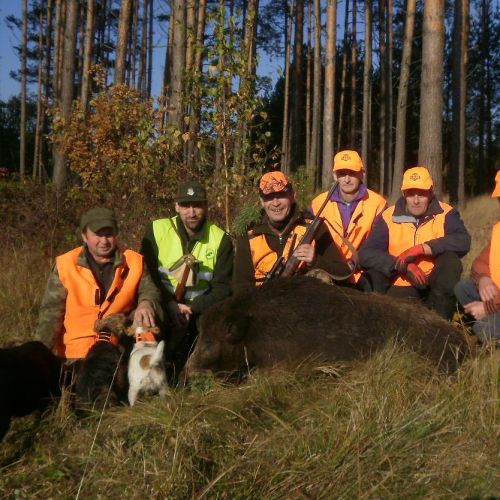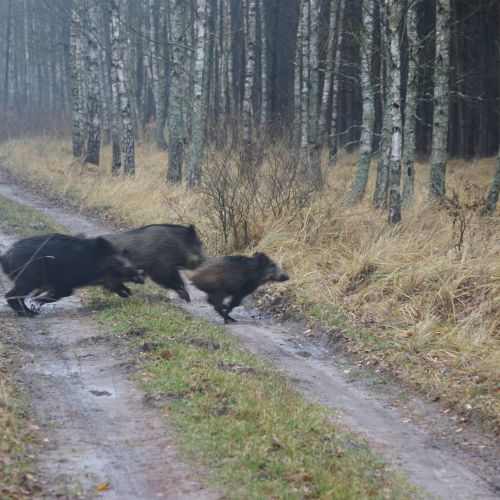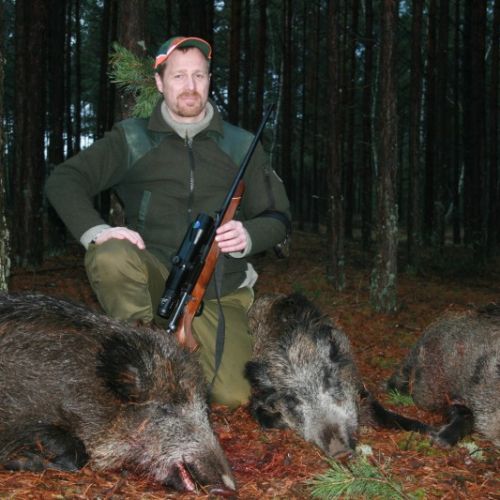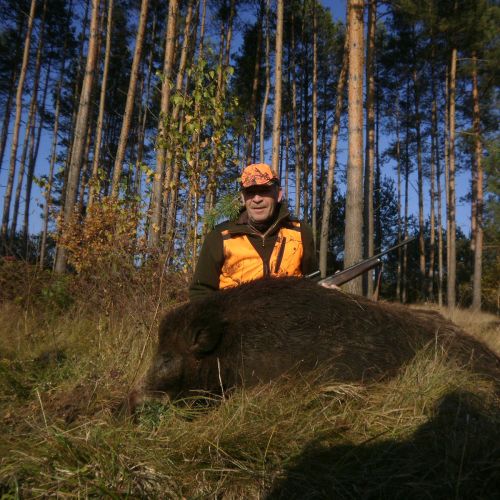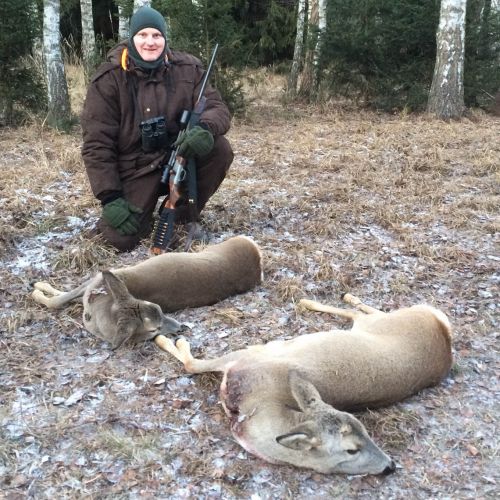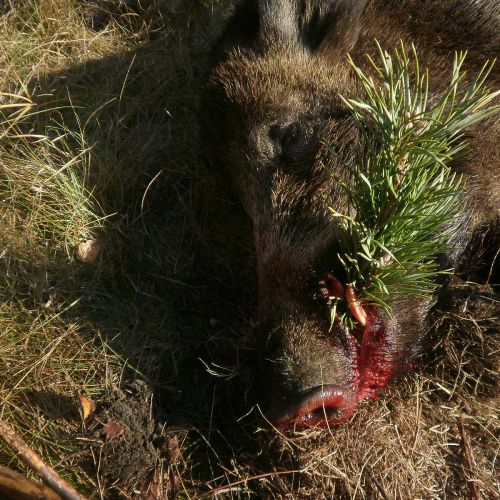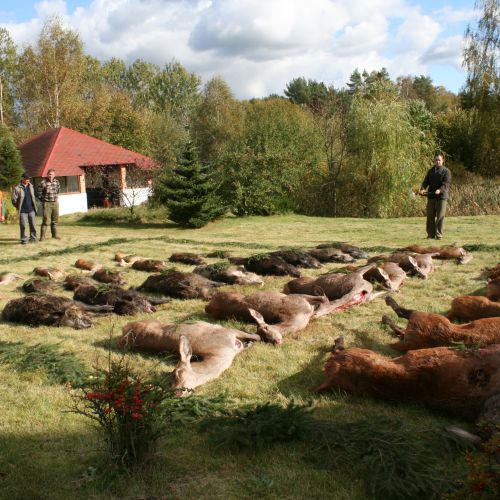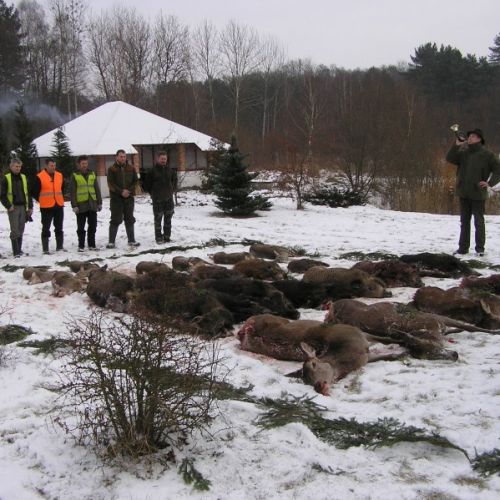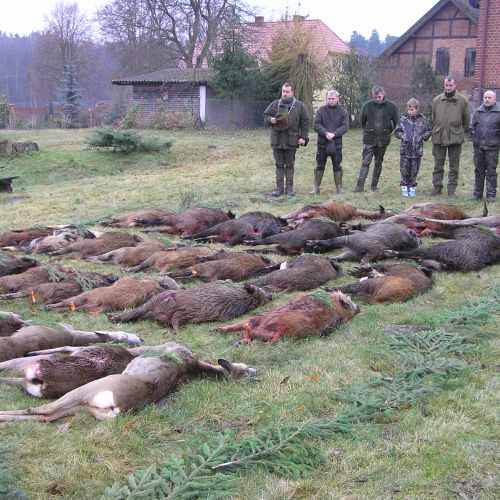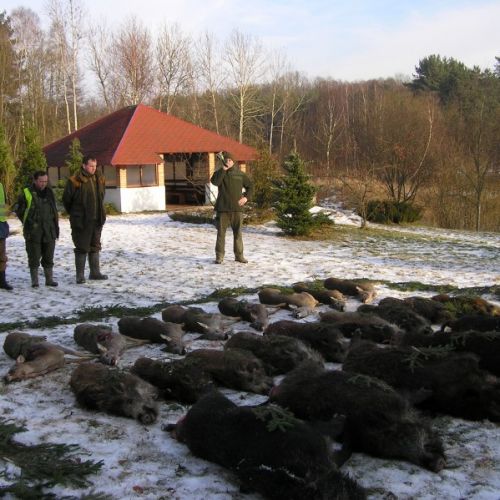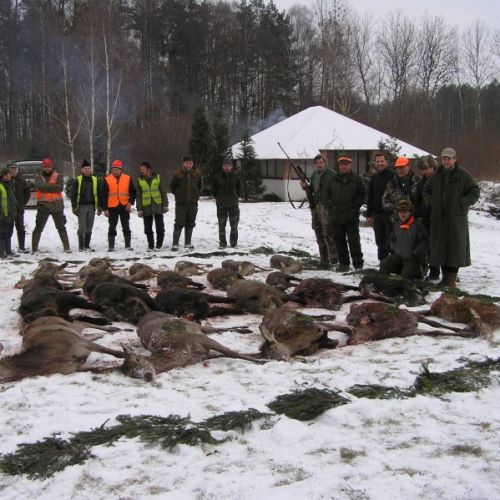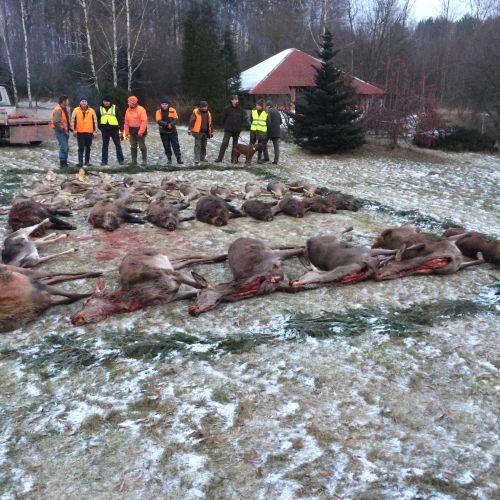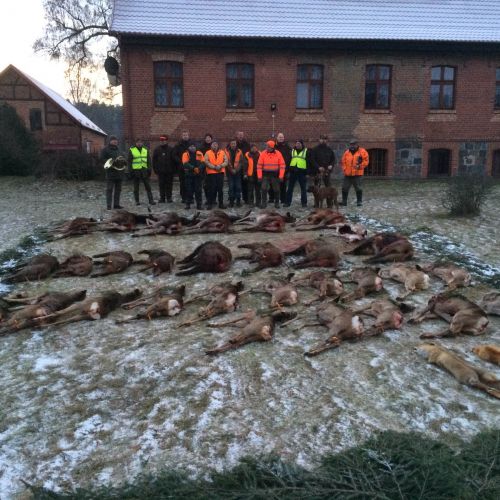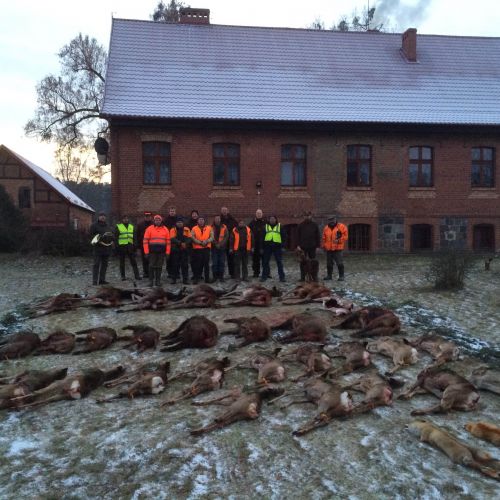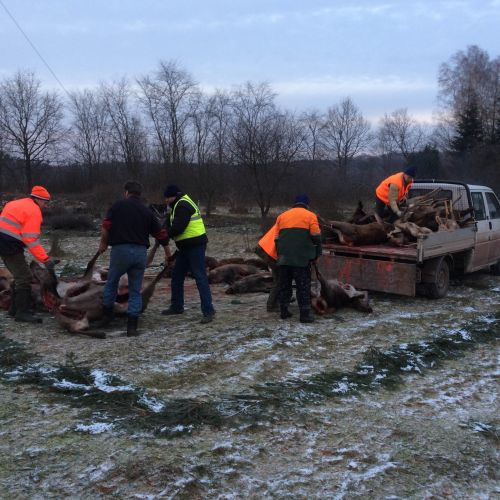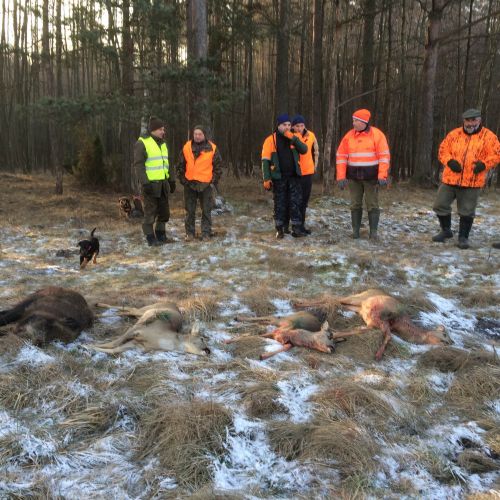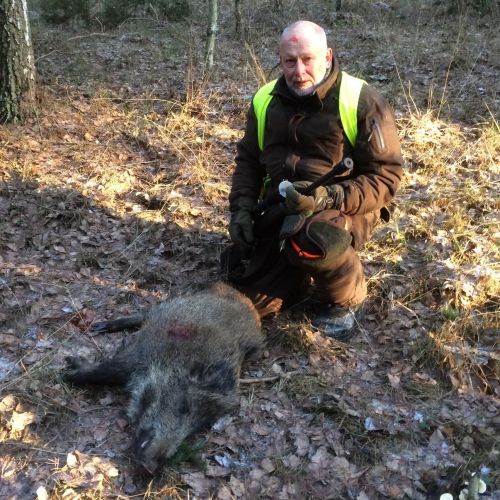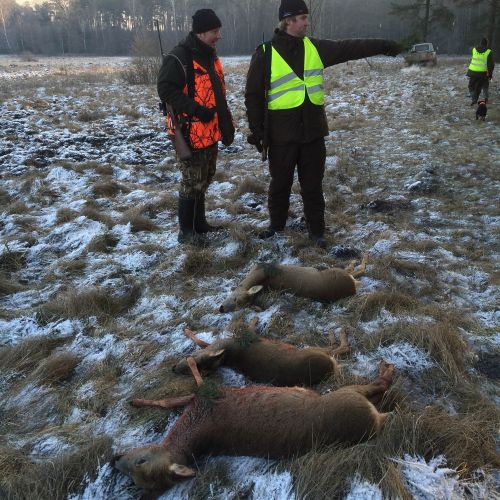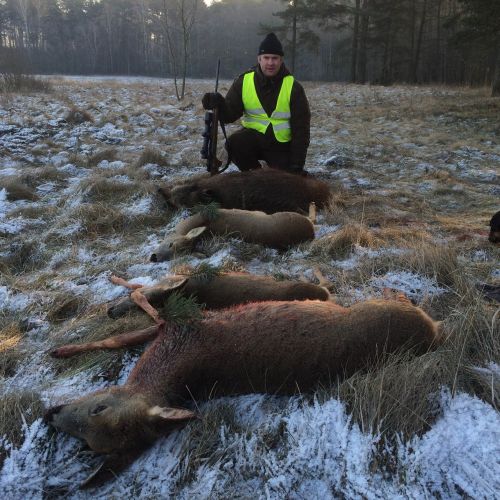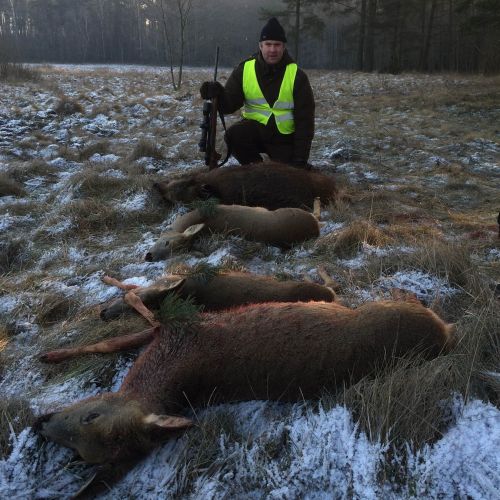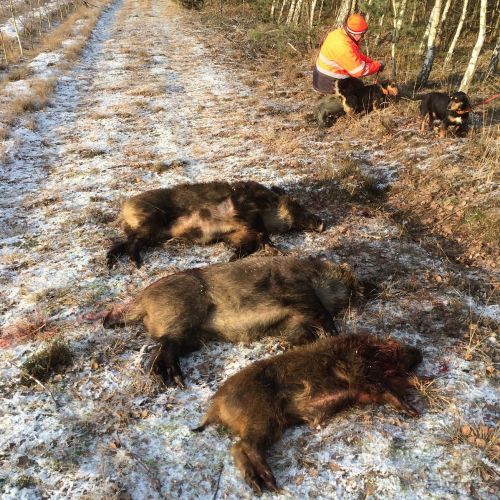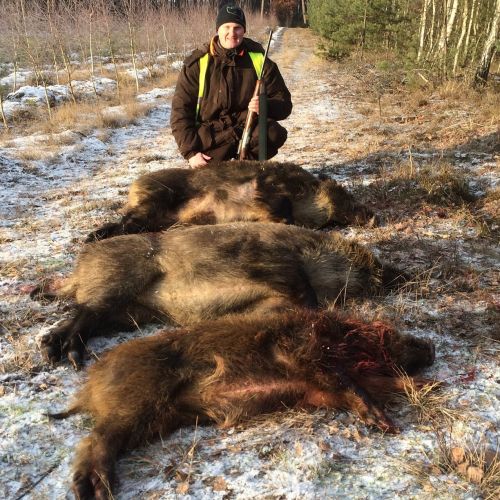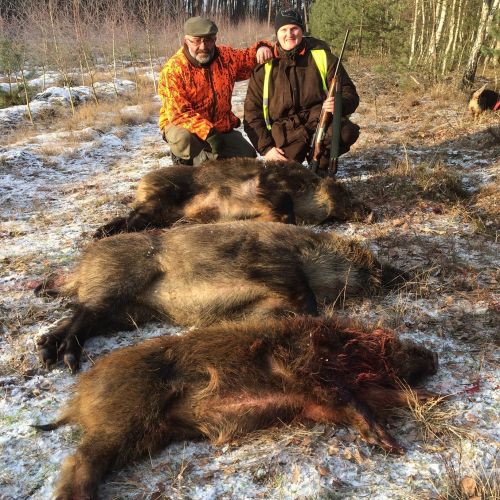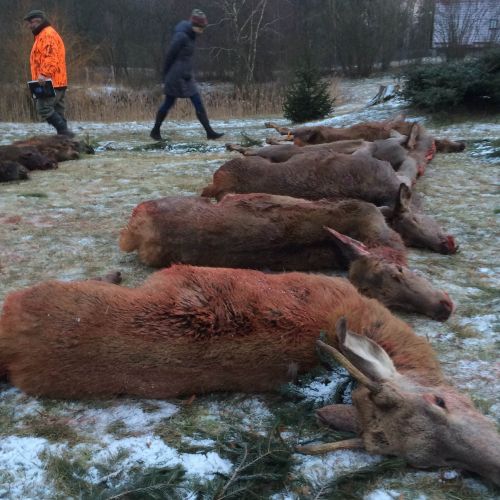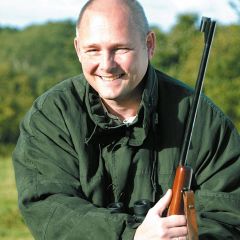Kombinationsjagd in Wierzchlas
Beliebte Oberförsterei mit guten Beständen an Schwarz-, Rot- und Rehwild. In diesem Revier haben wir mit den Kombinationsjagden begonnen. Guter Standard, gute Unterkunft mit einer gemütlichen Atmosphäre. Ausgezeichnetes Essen. Ausgezeichnetes Essen.
Lesen Sie mehr über die Kombinationsjagd in Polen
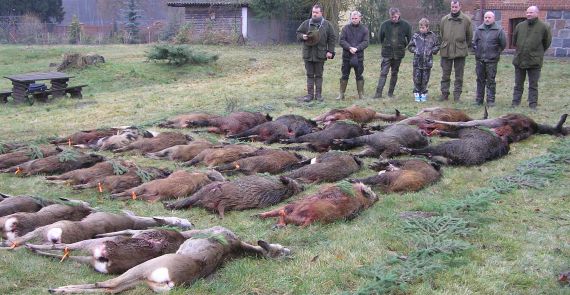
Höhepunkte
- 11.773 ha großes Revier
- Jährlicher Abschuss: 138 Stück Schwarzwild, 100 Stück Rotwild, 77 Stück Rehwild
- Bis zu 8 Kombinationsjagden jährlich – alternativ können kleine Drückjagden arrangiert werden
- Gute Unterkunft im Revier
4 TAGE AB €1,485
Ruhig, ungezwungen, gemütlich und preiswert. Ein echter Jäger gedeiht am besten in der Gesellschaft guter Freunde! .... Kombinationsjagden sind eine beliebte Kombination von kleinen Drückjagden und der Einzeljagd während der Herbst-/Wintermonaten.
Normalerweise benötigt man für eine kleine Drückjagd 5-7 Schützen. Diese Jagd findet normalerweise vormittags statt, während nachmittags eine individuelle Ansitz- oder Pirschjagd stattfindet. Bei diese Kombinationsjagden werden oft sehr anständige Strecken erzielt, und es ist immer sehr angenehm, die Zeit in der Gesellschaft seiner Jagdfreunde zu verbringen.
Wir haben Zugang zu einer ganzen Reihe der besten Oberförstereien in Westpolen. Diese staatlichen Reviere haben alle gut ausgebildetes, erfahrenes und sehr verantwortungsbewußtes Jagdpersonal. Alle haben eine Arbeit, die mit dem Revier verbunden ist. Die Jagd beginnt am frühen Morgen mit einem Briefing durch den Jagdleiter, der den Ablauf der Jagd erklärt und Sie über das Sicherheitsverhalten während der Jagd informiert.
Normalerweise gehen diese Kombinationsjagden über 4 Tage und schließen 3 Jagdtage ein. Es werden 5-7 Schützen benötigt, um die einzelnen Treiben gut abstellen zu können. Gejagt wird bis zum Mittag, dann wird jedem Jäger ein eigener Jagdführer zugewiesen und die Jagd in Form von Pirsch und ev. Ansitz auf Kahlwild und Schwarzwild fortgesetzt.
Diese kleinen Drückjagden sind eine ruhigere Alternative zu den großen Drückjagden. Der Anlauf pro Jäger ist in der Regel etwas höher als auf einer großen Drückjagd und die Kameradschaft untereinander wegen der kleineren Gruppe intensiver.
Generell ist es auch möglich, Wildbret zu günstigen Preisen zu kaufen. Viele Gruppen buchen ihre Jagd Jahr für Jahr mit ihren Jagdfreunden. Sie können Pauschalangebot buchen oder nach Preisliste jagen, je nachdem, was die Gruppe bevorzugt. Aber passen Sie auf - Sie können schnell süchtig nach diesen Jagden werden.
Videogalerie
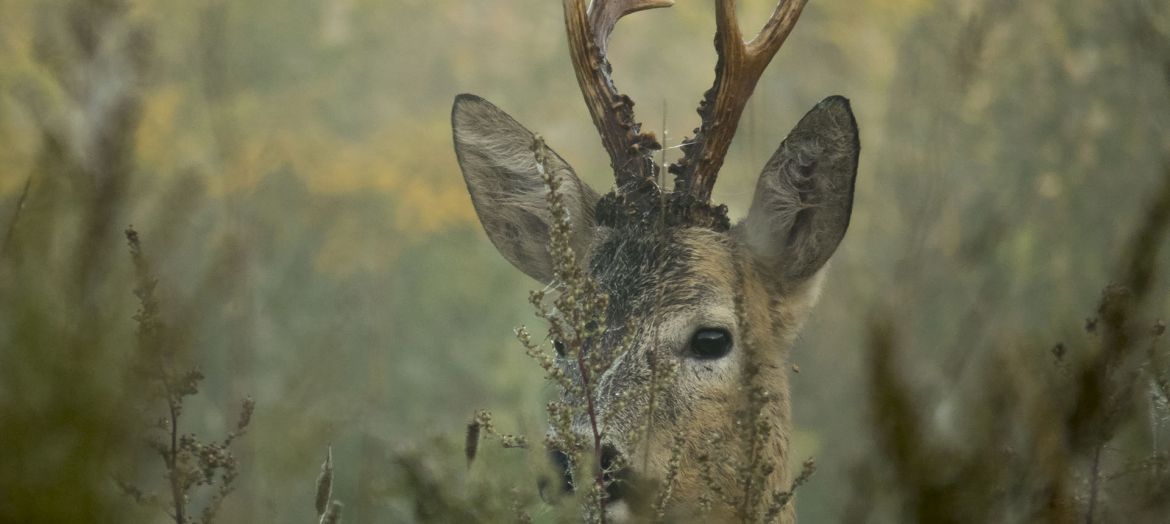
-
 Jagd in Polen
Jagd in Polen
Aufenthalt
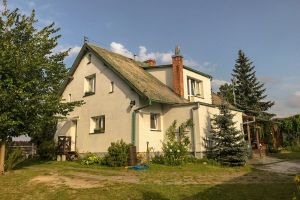
Aufenthalt - Wierzchlas
Untergebracht werden die Jagdgäste im kürzlich renovierten Forsthaus bei Förster Karol Malina und seiner Frau. Die Unterkunft ist in die Kategorie "S" eingestuft. Die Mahlzeiten hier sind ausgezeichnet und haben viel Lob von unseren Jägern erhalten, die uns auch gesagt haben, dass sie eine wirklich gemütliche Atmosphäre vorgefunden haben. Die Gästezimmer im...
Lesen Sie mehrRevier
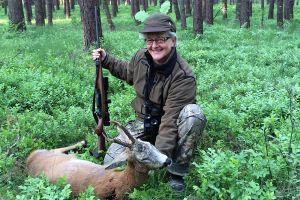
Wierzchlas
Das Revier Wierzchlas ist 11.773 ha groß, von denen 7.068 ha aus Wald und die restlichen 4.705 ha aus Ackerland, Wiesen und Feuchtgebieten bestehen. Der Wald besteht überwiegend aus Koniferen, mit verstreuten Gebieten dmit Eiche und Birke. Das Gelände ist überwiegend flach, obwohl einige Teile sanft hügelig sind. Es gibt zahlreiche Seen und Teiche, große und...
Lesen Sie mehrPartner

RDLP Torun
Wir arbeiten mit dem Bezirksforstamt Torun – Regionalna Dyrekcja Lasów Panstwowych w Toruniu oder kurz RDLP Torun – seit 21 Jahren direkt und davor über Wilson Jagtrejser (später Diana) zusammen. Unsere Partnerschaft umfasst 8 Staatsreviere, und wir haben langfristige Vereinbarungen mit allen. Der Rest (= 19) von insgesamt 27 Revieren der RDLP Torun ist für die...
Lesen Sie mehrJagdgeschichten
Michael Lassen i Wierzchlas
Jens Ulrik in Poland
Darz bór!
In the beautiful fall of Northern Europe, it is time to manage the roe deer population. In the hunting area Maniszewo alone they cull 170-200 roe does and fawns during every season. Follow Jens on a hunt for field dwelling roe deer in huge Polish fields October 2013.
One by one, the bagged deer were weighed and tagged while their weight and gender was carefully noted. We were two hunters who had been hunting for three days and when everything was accounted for, there was 286 kg’s of fine venison in cold storage destined for dinner plates all over Europe. Between us, we had managed to bag slightly less than 15% of the annual quota of the entire area.
Are you coming?
The opportunity to go to Poland had suddenly materialized out of thin air a little more than week earlier. The hunting area Maniszewo in Northwestern Poland was looking for hunters interested in roe deer culling on very short notice. That type of hunting is always a challenge and furthermore it is very inexpensive. The fact that we were welcome to take some of the fine meat home with us just added to the attraction. Not surprisingly, my good friend Eric and I proved easy to persuade.
Furthermore, I was going on a big trip to Africa a few weeks later and I really wanted to try out my brand new rifle kit consisting of a Mauser M03 with a Zeiss Victory HT 2.5-10x50 on top. This was the perfect opportunity.
I picked up the rifle and scope the day before we headed for the hunt in Poland. Upon our arrival, we had a little less than an hour before we would head out on the first outing with our guides.
We were in luck! Behind the huge fenced garden of the guesthouse, there was a fine little 100 meter shooting range equipped with a homemade but very sturdy shooting bench. I quickly assembled the brand new rifle – it only took a few seconds – and I made a couple of crude paper targets with a ball pen on the back of some tax return slips from the bottom of the trunk. I knew that the gun makers at the Mauser factory had test-fired the rifle but I did not have a clue what ammunition they had used. I just hoped that the first shot with the Norma Oryx ammunition I had chosen for this hunt would land somewhere on the target so that I could start zeroing the scope properly.
Spot on!
With the rifle resting on my cap, I squeezed off the first shot. I clearly saw that the center of the reticle was comfortably within the blue ink dot as the shot rang out. I immediately took a close look at the target. Through this scope, I would easily be able to see any holes in the white paper but I found none.
We walked to the targets expecting anything. However, as we got closer a logical explanation became obvious. The bullet had punched a nice little hole in the small blue bull’s-eye exactly in the position of the crosshairs as the shot went off. Not a bad start at all! I went back and fired another shot. It also had the courtesy to land where I was aiming and thus I finished the fastest zeroing process I had ever experienced. Sometimes you simply get lucky – today it was my turn!
I matched the proper ballistic ring on the ASV+ ballistic turret to the flat shooting load I was using and felt as ready as I could be. Having faith in your equipment is a big part of any good hunting experience. On this particular hunt, I already trusted a scoped rifle that I had only fired twice!
Oceans of rapeseed
Half an hour later, I was sitting beside Zbigniew Jania in his tiny Suzuki 4WD on our way to the hunt. The hunting area of almost 18,000 hectares was divided in five subdivisions with a dedicated guide on each. Zbigniew’s area mainly consisted of big fields and to make things worse most of these fields were newly sown, black and barren. Therefore we were also allowed to hunt in one of the other subdivisions where the fields were greener and more attractive to the deer but even larger than in my guides main area. Several of these vast green oceans in the landscape were between 100 and 200 hectares from “coast to coast” without any form of natural cover.
I gazed at the scenery through the foggy window and thought that it would not be easy to get within shooting range of the roes in this wide-open terrain. My fears proved to be very real. Plenty of roe deer in small family groups filled the fields but they constantly fled in panic several hundred meters in front of the vehicle.
My guide stopped the engine at the end of a never-ending hedge stretching hundreds of meters in front of us only to disappear behind a low hill. The enormous field was harvested but there were plenty of green weeds scattered in tuffs all over the place. 500 meters away two roebucks were staring at us. Behind them, there was a roe doe and two fawns browsing. There was absolutely no chance of getting in range of these animals but my experienced guide had another simple plan. Slowly and with the wind in our faces, we would walk along the hedge up the hill. With a little luck, we would surprise some deer on the other side of the hilltop at more reasonable distances.
Far out
We mowed cautiously forward. The bucks we had seen when we started our stalk intensely followed every step we took. We approached the hilltop. Suddenly Zbigniew froze and raised his binoculars. On the other side of the hill, numerous little groups of deer were browsing the field!
I moved behind him and followed him in a smooth silent gait towards the top. He often stopped to look at the animals for a long time before slowly moving on. On the top, he put his three-legged shooting sticks up and used them to steady his binoculars. The nearest group of deer was foraging quite a bit in front of us. It was a doe with two fawns and a young doe from last year.
The disappointment in my guide’s voice was clear. “They are too far away”, he said.
”How far?” I asked silently blaming myself for not having a rangefinder with me.
His reply fell withour hesitation in the tone of voice you would expect from a man who has laid eyes on tens of thousands of roe deer through the years. “250 meters!” I lifted the ASV+ turret on the riflescope and turned it to the clear line between the 200 and 300 meter markings.
Zbigniew saw my move and understood immediately. Without uttering a word, he took a long step to the side to allow me free access to the shooting sticks. I placed the forearm in the fork of the sticks, turned the magnification to 10X and cocked the rifle. Zbigniew was staring at the deer seemingly very keen not to miss the show that was about to unfold before his eyes.
Moment of truth
”The right one!” he said to let me know that we were trying to bag the young doe. Less than a second later, the blast of the muzzle rolled over the landscape. Within the time it takes to blink, we got the sound of the bullet impact in return. It sounded like a distant but heavy blow to a large drum. The deer was knocked to the ground. It got up, while the others took flight, but it fell over immediately and never got on its feet again.
A loud and spontaneous ”WOW!” was Zbigniew’s only comment. I turned towards him and was greeted by a wide smile. Roe deer was running wild all over the field and we both saw a single doe crossing the field behind us at full speed. Zbigniew quickly moved the sticks and said ”shoot if you get the chance!”. I had dialed the ASV+ turret back to 170 meters and thus I was ready for any distance between 150 and 200 meters.
I followed the jumping roe through the scope. Just a few seconds before it reached the salvation of the hedge it made the fatal mistake that seems imbedded deeply in the genes of roe deer. It stopped to orientate. The firing pin fell instantly – and so did the deer. The distance was approximately 180 meters. I was more than satisfied. The first two shots at game with the new rifle had resulted in to fine roe does. They fell less than 20 seconds apart and yet at a distance between them of nearly half a kilometer.
The guide went to pick up the car while I went to wait by the nearest deer.
The last bite
Zbigniew was there in a few minutes and he started the mandatory ceremony to honor the killed animal at once. He picked a bundle of short rapeseed twigs and placed most of them in the mouth of the roe as a last bite before its final journey to the eternal rapeseed fields. He gently dipped the remaining two twigs in the blood of the entrance wound, placed one on top of the bullet hole and presented me with the other carefully placed on his own hat. As I took it, he gave me a firm handshake and said “Darz Bór!” – an old Polish greeting between hunters. I replied using the same words and carefully placed the little twig with the heartblood of my quarry in my hat. It is a beautiful tradition and to Zbigniew there were no exceptions – all the game we killed was honored with the same heartfelt respect.
We arranged the two animals for a photograph and in a matter of a few minutes, they were gralloched and loaded on the back of the car.
During the following days I had the good fortune to bag another eight of these shy Polish roe deer. The average shooting distance was in the area of 175 meters while a few were shot at as much as 250 meters. In total, I now have 12 empty spaces in my first box of ammo for this rifle. I am fairly content with the statistics so far considering I used two shots on paper. I choose to believe that the thousands of shots I have fired on paper targets during the past few decades have somehow improved my luck.
Grand finale
When we ended the hunt after three short days, we arranged all the deer for a photo on the lawn in front of the hunting house. As a final ceremony, our guides played the horn signals for “roe deer” and “Darz Bór” over the dead animals. The trophies of this remarkable three-day adventure were plentiful. First and foremost there is the happy memories of the hunt and the nice trip in the company of a good friend. However, the nice photos and not least the fantastic roe deer venison that hibernates in my deep freezer are also great trophies indeed.
When I raise my glass at our dinner table to toast “Darz Bór!” in the months to come my thoughts will fly to enormous Polish fields filled with light-footed roe deer, salty guides and a rifle I could blindly trust…
Wildarten
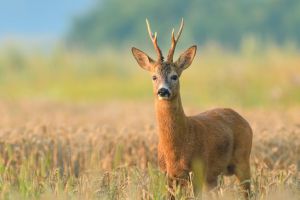
Bock/Rehbock/Rehwild (Europa)
Videnskabeligt navn: Capreolus capreolus Underarter: Vi har ikke medtaget underarter af Capreolus capreolus, da der hersker tvivl om deres berettigelse som selvstændige underarter.
Lesen Sie mehr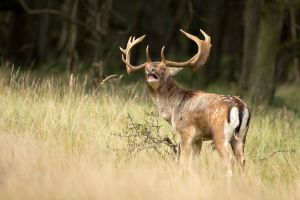
Damwild/Damhirsch (Europa)
Wissenschaftlicher Name: Cervus dama Unterarten: keine. Einige Autoren jedoch betrachten den Mesopotamischen Damhirsch (C. d. mesopotamica) als Unterart, während andere ihn als eigene Art (Cervus mesopotamica) betrachten. Verbreitung: Damwild stammt ursprünglich wohl aus Kleinasien, ist aber heute vom Mittelmeergebiet ausgehend, vermutlich schon zu römischer Zeit in ganz Europa...
Lesen Sie mehr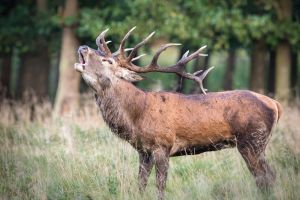
Rothirsch/Rotwild (Europa)
Wissenschaftlicher Name: Cervus elaphus Unterarten: Von den 11 anerkannten Unterarten der Art Cervus elaphus leben 3 in Europa: 1. Westeuropäischer Rothirsch (C. e. elaphus [syn.scoticus, hippelaphus, atlanticus, hispanicus), 2. Osteuropäischer Rothirsch (C. e. montanus), 3. Sardischer Rothirsch (C. e. corsicanus). Verbreitung: 1. Westeuropäischer Rothirsch: West- und Osteuropa...
Lesen Sie mehr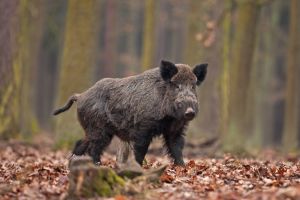
Wildschwein (Europa)
Wissenschaftlicher Name: Sus scrofa Unterarten: Es werden von einigen Autoren allein in Europa sechs Unterarten differenziert. Allerdings scheint es nicht sehr glücklich, diese aufrecht zu erhalten, da es zahlreiche Kreuzungen zwischen den einzelnen Unterarten (unter anderem zur „Blutauffrischung“ gegeben hat. Aus diesen Gründen soll hier nicht von Unterarten gesprochen...
Lesen Sie mehrAllgemeine Bedingungen für Polen 2020/21
Einzelzimmerzuschläge
Unsere Kunden werden normalerweise in Zwei- oder Mehrbettzimmern untergebracht, wenn nichts anderes vereinbart wurde. Es wird jedoch für Einzelzimmer den Zuschlag aufgefordert, wenn
• Sie alleine reisen
• eine Gruppe eine ungerade Anzahl von Teilnehmern hat
• Ihnen ein Einzelzimmer zugeteilt wird - EGAL AUS WELCHEM GRUND
• Sie in einem Mehrbettzimmer alleine schlafen
• Sie ein Einzelzimmer gebucht haben
Transporte während der Jagd
In den meisten Revieren haben wir einen Fixpreis vereinbart. Der Preis gilt pro Tag und Jäger unabhängig davon ob sie das Fahrzeug alleine oder von mehreren Jägern genutzt wird. Der Preis variiert von Euro 40 - Euro 60 pro Tag/Jäger.
Die Jagd
In Polen wird immer mit Jagdführung 1:1 gejagt, d.h. dass jeder Jäger einen eigenen Jagdführer hat. Der Jagdführer ist für die Selektion verantwortlich, aber es ist immer der Gastjäger, der nach der Freigabe vom Jagdführer entscheidet, ob er schießen möchte oder nicht. Der Jagdführer wird immer sein Bestes geben, um den Wünschen des Gastes zu entsprechen, aber es ist immer die Person „hinter der Büchse“, die die endgültige Verantwortung trägt.
Zusätzliche Jagdtage
Wenn Sie Ihren Aufenthalt um einen oder mehrere Tage verlängern wollen, müssen Sie dies während Ihres Aufenthaltes mit uns oder mit dem Dolmetscher vereinbaren. In Einzelfällen wird dies vielleicht nicht möglich sein.
Abbruch der Reise
Wenn Sie, aus welchen Gründen auch immer, das Revier vorzeitig verlassen, erfolgt keine Rückzahlung der nicht in Anspruch genommenen Leistungen.
Zusätzliche Mahlzeiten
Ein verlängerter Aufenthalt beinhaltet auch eine Mahlzeit und wird mit Euro 22,- berechnet. Ein verlängerter Aufenthalt zweier Mahlzeiten wird als ganzer zusätzlicher Tag berechnet.
Hunde
Wenn Sie Ihren Jagdhund mitbringen wird dafür in der Regel ein Betrag von Euro 10,-/Tag in Rechnung gestellt. Bitte beachten Sie, dass nicht alle Reviere die Mitnahme des eigenen Jagdhundes gestatten. Wenn Sie Ihren Hund nach Polen mitnehmen müssen Sie den gültigen “Heimtierpass” mitbringen und der Hund muss einen Mikrochip zur Identifizierung tragen.
Dolmetscher
In allen Revieren ist ein Dolmetscher während des Jagdaufenthaltes Pflicht. Bitte informieren Sie uns ob Sie einen englisch- oder deutschsprechenden Dolmetscher bevorzugen. In einigen Revieren übernehmen der Jagdförster diese Funktion.
Vereinbarungen
Vereinbarungen zwischen DIANA’s Kunden und dem Personal/dem Jagdförster in den Revieren werden unter keinen Umständen akzeptiert. Jeder Jagdgast haftet für das unterschriebene Protokoll - ungeachtet ”privater” Vereinbarungen - mündlicher oder schriftlicher.
Trophäenvorauszahlung
Wenn Sie eine Preislistenjagd buchen, wird eine Trophäenvorauszahlung in Rechnung gestellt. Nach Ihrer Rückkehr wird dieser Betrag von den tatsächlichen Kosten in Abzug gebracht. Folgende Trophäenvorauszahlungen werden bei Buchung fällig:
| Rothirsch | Euro 1.100,- |
| Rehbock | Euro 200,- |
| Damhirsch | Euro 400,- |
| Wildschwein | Euro 200,- |
| Muflon | Euro 800,- |
| Drückjagd | Euro 410,- |
Schonzeitvergehen
Das polnische Ministerium für Umweltschutz hat folgende Gebühren für erlegtes Wild ausserhalb der Jagdzeiten eingeführt:
Rothirsch: 5.800- zloty
+ 2.000- zloty für Trophäen bis 5,5kg
+ 7.000 zloty für Trophäen über 5.5kg
Damhirsch: 2.300- zloty
+ 1.500- zloty für Trophäen bis 2,6kg
+ 3.000 zloty für Trophäen über 2.6kg
Sikahirsch: 5.500 zloty
+ 1.000 zloty für Trophäen bis 2.0kg
+ 2.500 zloty für Trophäen über 2.0kg
Roe deer: 2.000 zloty
+ 1.000 zloty für Trophäen bis 430g
+ 5.000 zloty für Trophäen über 430g
Mufflon: 1.800 zloty
Wildschwein: 2.300 zloty
Andere Wildarten: 1.000 zloty
Wenn man ein Stck. Wild erlegt innerhalb der Jagdzeit aber OHNE Erlaubnis vom Jagdführer, wird die Trophäenabgabe + 100 Strafe in Rechnung gestellt.
Protokoll
Wir empfehlen allen Kunden die Trophäenvermessungen selbst zu überprüfen bevor sie das Protokoll unterschreiben, unabhängig welche Verrechungsart, laut Preisliste oder Fixpreispaket, sie gebucht haben. Wenn ein Jäger die Trophäe ohne Abkochen mitnehmen will, z.B. für eine Kopfmontage, wird das ganze Haupt gewogen und das
Trophäengewicht im Revier geschätzt. Der Trophäenpreis richtet sich nach dieser Schätzung. Wir können daher spätere diesbezügliche Reklamationen nicht anerkennen. Diese Vorgangsweise gilt auch bei Schwarzwild. Wenn ein Jäger das ganze Keilerhaupt mitnehmen möchte, so wird die Trophäe wie folgt bemessen:
Der sichtbare Teil der Zähne beträgt 1/3 der Gesamtlänge. Trophäen werden in der Regel 24 Stunden nach dem Abkochen vermessen bzw. gewogen. Wenn der Jagdgast früher das Revier verlässt, wird das Gewicht der noch nicht getrockneten Trophäe in das Protokoll eingetragen und verrechnet. Es gibt später keine Möglichkeit
dieses Gewicht zu beanstanden. Eventuelle Beanstandungen, bzw. wenn Sie eine Kompensation oder eine Rückzahlung, aus welchen Gründen auch immer, fordern, müssen in dem Protokoll vermerkt sein. Andernfalls können sie nicht bearbeitet werden. Bitte beachten Sie, dass Sie mit ihrer Unterschrift im Protokoll bestätigen, das alles was darin angeführt ist, zu 100% richtig ist.
Endabrechnung
Die Endabrechnung wird von uns erst nach Erhalt des polnischen Protokolls vorgenommen, was etwa 4-6 Wochen dauern kann, unabhängig davon ob Sie Geld zurückbekommen oder eine Nachzahlung fällig ist. Evtl. extra Rechnungen sind nach 10 Tagen fällig – egal ob Sie die Trophäe bzw. Decken/Schwarten im Revier gelassen haben für eine spätere Abholung bzw. einen späteren Versand. Bitte beachten Sie, dass alle (!) Abschüsse, auch sog. „Hegeabschüsse“, abgerechnet werden.
Alkohol
Es ist gesetzliche Pflicht, dass die Polizei über sämtliche Jagdarrangements spätestens 7 Tage vor dem Anreisetag informiert werden, mit Angabe von genauem Jagdtermin bzw. genauer Unterkunftsadresse. Dies Bedeutet dass es zu unangemeldeter Kontrolle kommen kann. Die Polizei wird überprüfen, ob alle Papiere in Ordnung sind, und ob mit Alkohol im Blut gejagt wird. Beim Autofahren in Polen ist der erlaubte Promillesatz 0,0% und dasselbe gilt bei der Führung einer Waffe.
Kaliberwahl
Die gesetzliche Regelung ist eindeutig. Rehwild: Auf 100m sollte die Kugel mindestens eine Auftreffenergie von 1000 Joule betragen. Alle anderen Schalenwildarten: Auftreffenergie von mindestens 2000 Joule auf 100 Meter.
Drück- und Riegeldrückjagd
Bitte beachten Sie, dass Sie bei Drück- und Riegeldrückjagden nur Zielfernrohre mit max. 3 facher Vergrößerung verwenden dürfen. Variable ZF, wie z.B. 2,5-10 fach oder 3-12 fach sind zugelassen. ZF mit einer feststehenden Vergrößerung von mehr als 3 fach, wie z.B. 6x62 oder 8x56 sind nicht zugelassen. Laut dem polnischen Jagdgesetz ist es Pflicht, das jeder Jäger Minimum 2 Elemente in fluoreszierenden Farben, d.h. gelb oder orange, trägt.
Trinkgeld
Es ist üblich dem Jagdführer, dem Dolmetscher und der Küche ein Trinkgeld zu geben, wie viel obliegt natürlich Ihrem Ermessen und Ihrer Zufriedenheit mit deren Leistungen.
Vollmondkalender 2020/2021
10. Januar
09. Februar
09. März
08. April
07. Mai
05. Juni
05. Juli
03. August
02. September
01. Oktober
31. Oktober
30. November
30. Dezember
28. Januar
27. Februar
28. März
Jagdzeiten 2020/21
| Rehbock | 09.05.-30.09. |
| Ricke/Kitze | 01.10.-17.01. |
| Rothirsch | 21.08.-28.02. |
| Rotkalb | 01.09.-28.02. |
| Rottier | 01.09.-17.01. |
| Damhirsch | 01.09.-28.02. |
| Damkalb | 01.09.-28.02. |
| Damtier | 01.09.-17.01. |
| Keiler, Überläufer, Frischling | Ganzjährig |
| Muffelwidder | 01.10.-28.02. |
| Muffelschaf/-Lamm | 01.10.-17.01. |
| Fuchs | 30.05.-31.03. |
| Dachs | 01.09.-30.11. |
| Marderhund | Ganzjährig |
| Wildent | 15.08.-21.12. |
| Wildgans (Westpolen) | 01.09.-31.01. |
Preise

Im Preis enthalten
- 3 Tage Aufenthalt mit Vollpension
- 3 Tage Kombijagd
- Feier Abschuss von Schwarzwild, Kahlwild, Damkahlwild und Ricken und Kitzen auf der Drückjagd
- Organisationsgebühr für Drückjagd
- Transport während der Drückjagd
- Alle Gebühre und Lizenzen
- Abkochen von Trophäen
Im Preis nicht enthalten
- Endgültige Abrechnung der Trophäen bei indiv. Jagd
- Transport während der Jagd, PLN 360,- pro Jäger/Tag
- Zusätzlicher Jagdtag EUR 310,-
- Aufenthalt ohne Jagd/kein Jäger EUR 165,-
- Zuschlag für Einzelzimmer pro Tag EUR 25,-
- Dolmetscher pro Person / Tag (freiwillig, muss im voraus gebucht werden) € 81,-
- EU Haftpflichtversicherung, Euro 10,00 pro Person (obligatorisch)
- Reiseversicherung
- Rücktrittsversicherung
- Trinkgeld
- Aus-der-Decke Schlagen € 65,-
- Aus-der-Decke Schlagen für Kopfmontage:
Rothirsch € 152,-
Damhirsch € 122,-
Rehbock/Schwarzwild € 92,- - Kauf von Decke pro Kg € 16,-
- Kauf von Decke von Fuchs und Marderhund € 33,-
- Nachsuche mit Schweißhund € 130,- (individuel jagd)
- Zusätzlicher Pirschgang / Nachtjagd € 80,-
Diana Jagdreisen hat eine Zusammenarbeit mit Europäische Reiseversicherung (ERV) abgeschlossen und freut sich, Ihnen eine ideale Reiseversicherung für Ihre Jagdreise sowie eine Reiserücktrittsversicherung anbieten zu können, falls Sie die Reise aufgrund von Krankheit absagen müssen.
Möchten Sie eine Reise- oder Reiserücktrittsversicherung über Diana Jagtrejser abschließen, können Sie sich an Ihren Reisekonsulenten oder unseren Support unter der Telefonnummer 62 20 25 40 wenden oder eine E-Mail an info@diana.dk senden.
Trophäenpreisliste
Erlegtes Wild wird laut geltender Preisliste abgerechnet:
Rotkahlwild € 120,00
Rehwild € 65,00
Damkahlwild € 107,00
Schwarzwild:
Keiler:
140 mm - 159 mm € 500,00
160 mm – 199 mm € 660,00 + € 16,75 per mm über 160 mm
200 mm und darüber € 1.330,00 + € 26,60 per mm über 201 mm
Keiler unter 140 mm, Frischlinge und Überläufer werden wie folgt berechnet:
Frischling, Überläufer:
bis 29,99 kg € 105,00
30-59,99 kg € 206,00
Ab 60 kg € 420,00
Anschweissen € 172,00
Preis auf 15/1-2025











